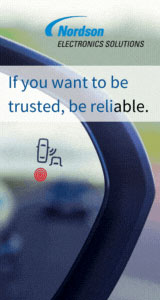|

|
|
| Ask the Experts | |||||||
|
|||||||
|
March 24, 2008 - Updated March 24, 2008 - Originally Posted BGA VoidsWe planning to switch solder paste from Sn63/Pb37 to Sn62/Pb36 Ag2 solder for our BGA process. What are the pro's and con's of using the SN62/Pb36 Ag2 solder paste vs. SN62/Pb37 solder paste? Will it minimize voids in our BGA process? R. M. |
|||||||
| Expert Panel Responses | |||||||
|
Changing from Sn63 to Sn62 should have minimal impact on the amount of voiding. The degree of voiding is far more dependent on solder paste flux chemistry and the reflow profile. Selecting the right solder paste for low voiding can have a huge impact on the amount of voiding since wetting speed and solvent choice in the solder paste can greatly influence the size and amount of voids. If you need specific advice on a low-voiding solder paste, it is suggested to directly contact your solder paste vendor and inquire. An optimized reflow profile can also reduce voiding. In general, a longer & hotter soak temperature and a lower peak temperature have been found to reduce voiding in most applications. If you need advice regarding your specific reflow profiling challenges, you can contact the technical service staff at your solder paste vendor.
General Manager - Electronic Assembly Americas DEK International Mr. Smith has been supporting customers in the electronics assembly industry since 1994. His expertise is focused on solder paste printing and reducing soldering defects. He holds a BS in Chemical Engineering and an MBA in Marketing. He has authored several papers in trade magazines and at industry conferences. He is an SMTA Certified Process Engineer.
My understanding is the additional 2% Ag adds tensile strength to the joint as its primary benefit. I do not believe it will affect voiding rates. Some voiding is considered to be beneficial, the question I think is whether current rates of voiding are causing failures or simply concern. There are systems available that will allow the soldering to be done under a vacuum reducing voids to levels close to zero. However the cost is high and there are added issues that need to be considered.
CEO ATEK llc Allen Duck is a 20-year Electronics Industry veteran with Global experience in multiple fields of technology and management. He started A-Tek in 2006 to provide a sales and service channel for international equipment companies wishing to offer value based solutions to USA companies.
|
|||||||
| Submit A Comment | |||||||
|
Comments are reviewed prior to posting. You must include your full name to have your comments posted. We will not post your email address. |
|
Free Newsletter Subscription
Circuitnet is built for professionals who bear the responsibility of looking ahead, imagining the future, and preparing for it. Insert Your Email Address |
|

|




